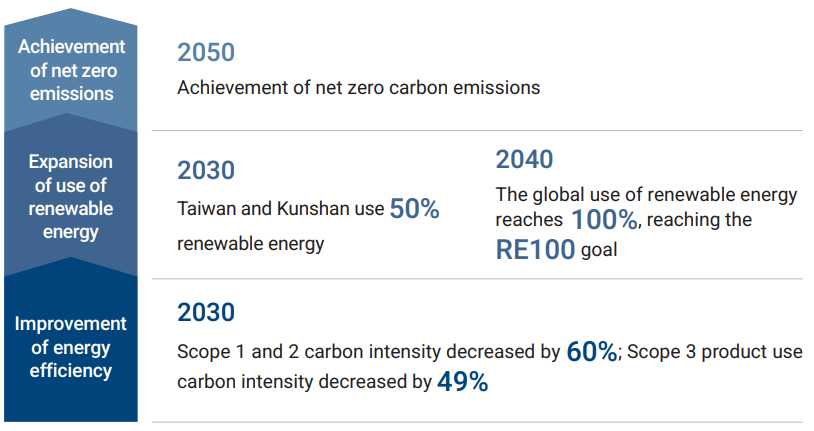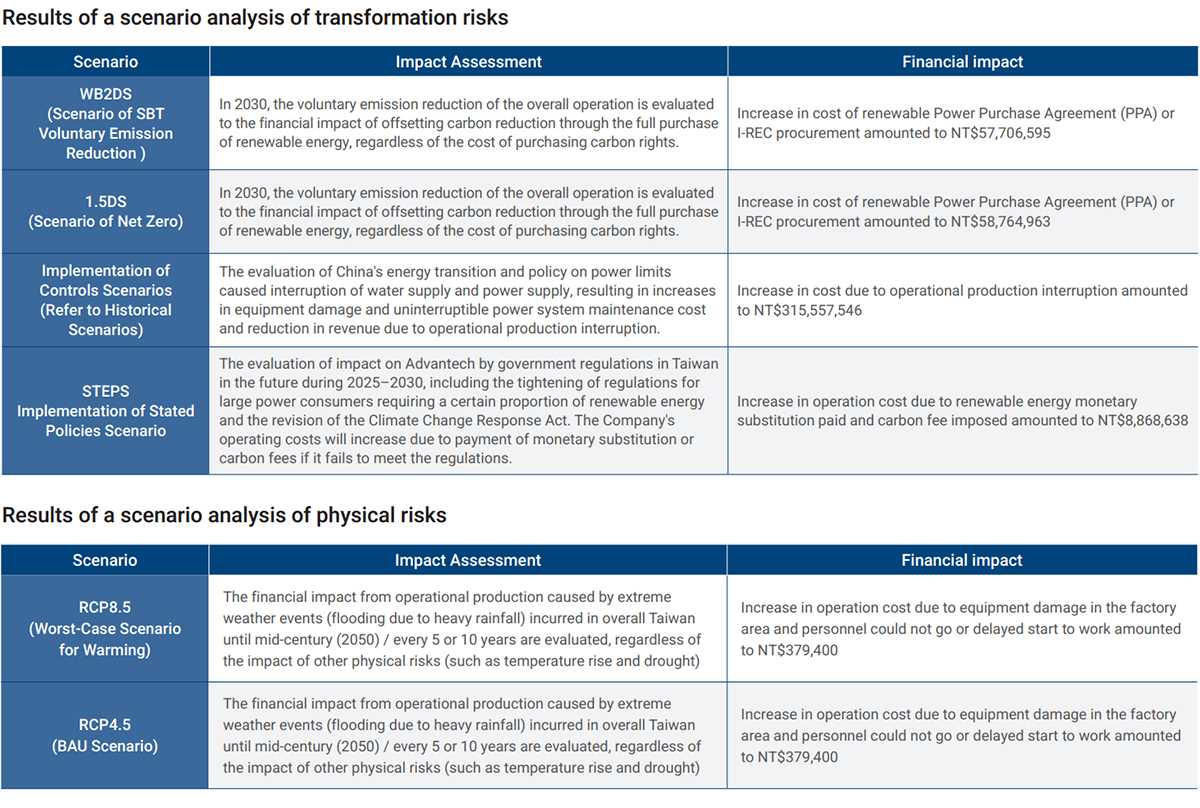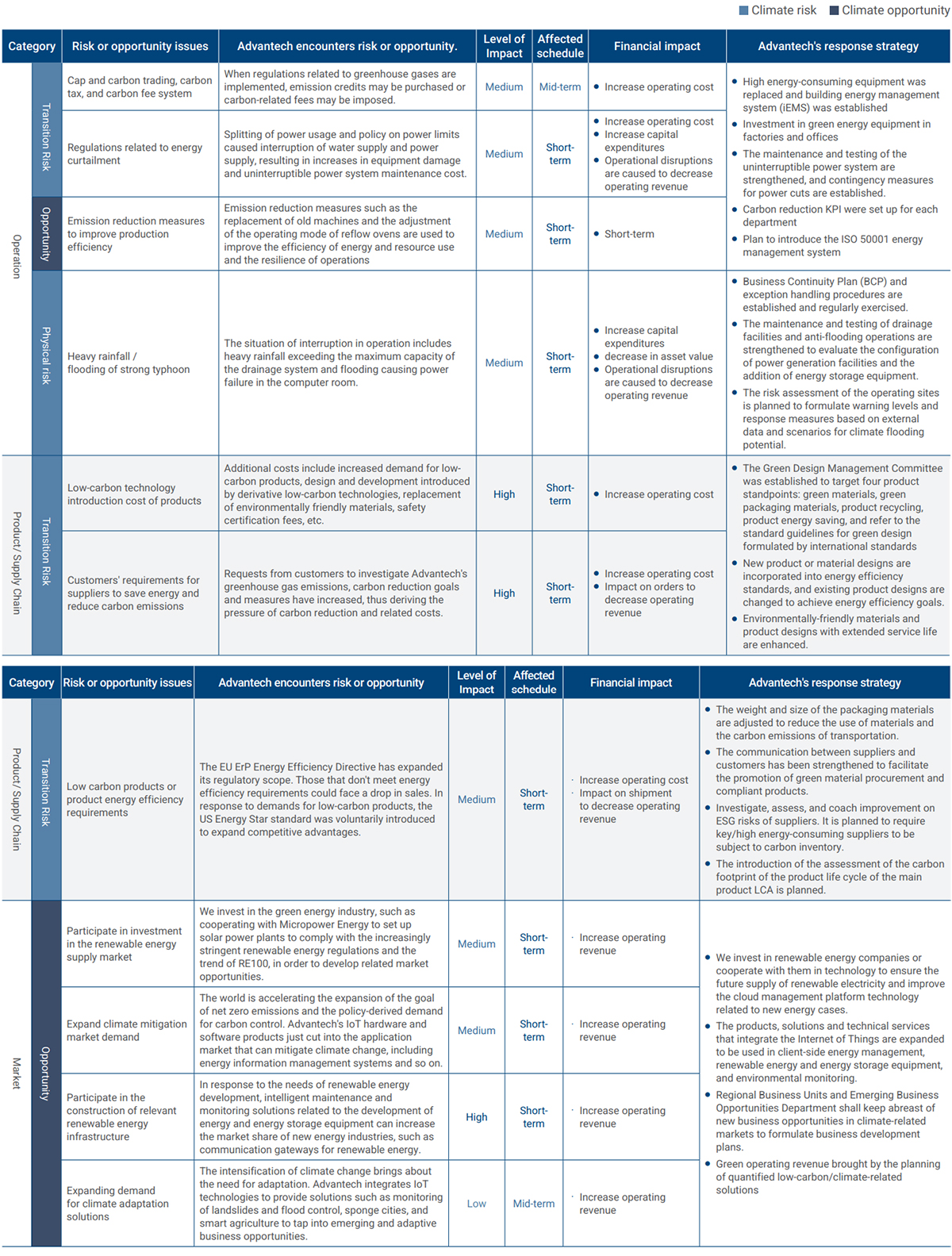Climate Change Strategy and Management
As the world's largest provider of industrial computer and Internet of Things technologies and services, Advantech understands its responsibility to the global environment. The Company's policy statement on climate change is aligned with the Paris Agreement's goal of keeping warming below 1.5°C. The Science Based Target (SBT) was adopted and committed in 2021. Since then, we have further committed to join the RE100 initiative and set a net zero carbon emission target in 2023. Renewable energy is regarded as an important strategy towards net zero emissions, and it is planned to achieve 50% renewable energy use in Taiwan and Kunshan, China by 2030. Also, we will achieve 100% global renewable energy use by 2040 to achieve the goal of RE100, and achieve the goal of net zero carbon emissions by 2050.
Advantech has included climate change as one of the material risk projects of corporate sustainable management, and has managed it according to the two standpoints of "mitigation" and "adaptation." Meanwhile, we are also actively identifying risks, building adaptation capabilities, further researching and analyzing opportunities for climate change, and accumulating and deepening R&D momentum. We continue to invest in eco energy and in energy-saving products and solutions, and we are integrating them with the core business of energy management to promote energy saving and sustainability.
Advantech's Net Zero Vision

Advantech's Climate Change Development History
2019
- Launch of ISO 14064 Greenhouse Gas Inventory and Verification Program in Taiwan and Kunshan
- Base year for Advantech's ScienceBased Target (SBT)
- CDP Climate Change Ranking Receives 'B’
2020
- Establishment of ESG Corporate Sustainability Committee and ESG Office
- Introduction of green product plan to produce low-carbon products
- CDP Climate Change Ranking Receives 'B’
2021
- The Science-Based Target (SBT) adopted to comply with the international below 2°C
- Commitment and support for Task Force on Climate-Related Financial Disclosures (TCFD)
- 10 MW of low-carbon investment solar power plants to supply Taiwan factory
- CDP Climate Change Ranking Receives 'B’
2022
- Establishment of the Sustainability Development Committee (SDC) at the board level
- Completion of Task Force on Climate-Related Financial Disclosures (TCFD) risks and opportunities assessment
- Initiation of the inventory and verification plan for all categories of ISO 14064 Greenhouse Gas Scope 3 (Scope 3)
- Obtained green factory certification of Kunshan factory
- CDP Climate Change Ranking Receives 'B’
2023
- Commitment to join RE100 targets and process active low-carbon investment
- Link between the ESG KPI and the performance also approved by the Board
- Initiation of the subsidiary's greenhouse gas inventory and verification plan
- Initiation of the electricity consumption of the main business bases collected by iEMS in Taiwan and Kunshan
- Obtained green factory certification of Taiwan factory
- Obtained ISO 50001 certification of Taiwan and Kunshan operating bases
- Obtained the first product carbon footprint ISO 14067 certification
2024
- Completion and analysis of global iEMS collection and monitoring of electricity consumption at major global operating locations
- Calculation of carbon footprint of representative products of each business group
2026
- Completion of the global ISO 14064 greenhouse gas inventory and verification plan
2030
- Achieved Scope 1 and 2 carbon intensity decreased by 60%; Scope 3 product use carbon intensity decreased by 49% of SBT target
- Taiwan and Kunshan use 50% of renewable energy
2040
- The global use of renewable energy reaches 100%, reaching the RE100 goal
2050
- Achievement of net zero carbon emissions
Advantech’s SBT Targets
Advantech set a Science-Based Target (SBT) for carbon reduction in 2021. Using 2019 as the base year, we proposed targets of reducing the carbon intensity of Scope 1 and Scope 2 products by 60% by 2030, and reducing that of Scope 3 products by 49%. Furthermore, we passed a compliance review organized by the Science-Based Targets Initiative (SBTi). This makes us the third technology industry company in Taiwan to pass such a review, and we continue to move forward in pursuit of these goals.

1. Having set 2019 as the base year, Advantech applied for SBT targets in 2021. The period in which the relevant carbon reduction plans were drawn up. Therefore, relevant results was only available from 2022. For the relevant product carbon reduction plan, please refer to the Sustainability Report 4.1.1 Action Plan.
2. In 2021, products in Scope 3 were updated with carbon intensity figures, the original figure is -34.77%, and the corrected figure is -7.82%.
TCFD Governance Structure and Climate Management Strategy
Businesses face potential operational impact from the extreme climate events; from the low-carbon transition pressure brought about by the aggressive carbon reduction targets among a range of countries; and from the carbon reduction requirements imposed upon the upstream and downstream of the value chain. Under the impetus of our ESG Corporate Sustainability Committee ("the ESG Committee"), Advantech responded to this trend by having the ESG Office integrate cross-departmental resources and introduce the Task Force on Climate-related Financial Disclosures ("the TCFD") in responding to the increasing global need to identify the linkage between climate risk and financial impact. According to the TCFD guidelines, we have taken a systematic approach in measuring the climate risks and opportunities faced by the company. We have also thoroughly evaluated the climate change risks that the existing risk management procedures on which the Pan-Operational Risk Map focuses. Evaluation results and response plans have also been reported to the senior management of the SDC Corporate Sustainable Development Committee. Furthermore, the SDC Committee regularly reports the progress of climate management to the Board of Directors, so as to enhance the resilience in dealing with climate risks.
Climate Change Risk and Opportunities

Identification of Climate-Related Risks and Opportunities, and Financial Implications
ESG Office convenes members across departments to define risks and opportunities in accordance with the TCFD guidelines. In addition, it undertakes multi-faceted topic collection, crossed partmental discussions, and external consultation to specifically identify Advantech’s major risks and opportunities and the corresponding potential scenarios of occurrence and impact levels, and to analyze the possible financial impacts. Furthermore, we focus on industry characteristics and international contexts in three major aspects: operations (reductions and natural disasters), product and supply chains, and markets. We do so in order to facilitate the inventory of climate risks and opportunities at the Company's overall level, and to accurately propose relevant strategic countermeasures. Therefore, the Company's climate risk management covers the entire value chain (upstream, downstream, and our own operations).

Results of a scenario analysis of Climate Change risks

Climate-related risk and opportunity assessment results and response strategies

1. Impact level: conduct internal assessments based on the likelihood of occurrence and the degree of impact, dividing them into “High,” “Medium,” and “Low."
2. Impact period: considering when occurrence might happen, divided into "short term (< 3 years) ,” “medium-term (3-5 years),” and “long-term (>5 years).”
